Wet and dry curing offer distinct approaches to meat preservation. In wet curing, you'll submerge meat in a brine solution containing salt, sugar, and spices, resulting in milder, uniform flavors and tender textures. Dry curing uses direct salt application and air exposure, creating more concentrated, robust flavors and firmer textures. You'll find wet curing takes 5-7 days for bacon, while dry curing needs 7-10 days. Temperature control differs too – wet curing requires 34-38°F, while dry curing works best at 50-60°F. Both methods need 60-70% humidity for ideal results. Understanding these techniques helps reveal centuries-old preservation secrets.
Process and Application Methods

Wet curing methods vary considerably between concrete and meat preservation, with each requiring distinct techniques and careful attention to detail.
In concrete applications, you'll need to focus on maintaining consistent moisture through methods like spraying, ponding, or using saturated coverings. These practices help achieve optimal strength development in the concrete structure. You can apply water through continuous flooding or intermittent sprinkling, but you must avoid alternating between wet and dry conditions.
For meat preservation, you'll work with a brine solution that combines salt, sugar, and spices. You'll need to completely submerge the meat in this solution, ensuring even coverage for proper salt and spice penetration. The process requires careful monitoring of temperature and environment throughout the curing period.
The application methods for concrete include using moisture-retaining materials like plastic sheets or curing compounds, while meat curing relies on precise brine composition and timing.
In concrete, you might employ specialized techniques such as steam curing or curing blankets with heating elements to accelerate the process. Meanwhile, meat curing requires you to follow specific steps after the initial brine phase, including thorough rinsing and allowing the meat to rest before further processing.
Time and Duration Requirements
After mastering the application methods, understanding precise timing becomes the next key factor in successful curing. You'll find that dry curing typically takes longer than wet curing, with pork legs requiring 15-30 days while wet-cured counterparts might only need 2-6 weeks.
For smaller cuts, you'll need to adjust your timeline considerably. While dry-cured bacon might take up to 10 days, wet curing can accomplish the task in about a week. When you're using the injection method in wet curing, you'll often see faster results as the cure penetrates directly into the meat. These time-tested preservation techniques have been proven remarkably effective since ancient times before refrigeration existed.
| Cut Type | Dry Cure Time | Wet Cure Time |
|---|---|---|
| Pork Leg | 15-30 days | 4-6 weeks |
| Bacon | 7-10 days | 5-7 days |
| Turkey | 3-5 days | 1-2 days |
| Small Cuts | 5-7 days | 2-4 days |
| Ham | 20-25 days | 4-5 weeks |
Temperature control remains essential for both methods. You'll need to maintain 4-8°C for larger cuts and around 10°C for smaller pieces in dry curing, while wet curing requires consistent refrigeration throughout the process. Remember to monitor both methods regularly for signs of proper curing or potential spoilage.
Texture and Moisture Content

The fundamental differences in texture and moisture between curing methods become apparent as soon as you handle the finished products.
You'll notice that dry-cured bacon has a distinctly firmer texture, resulting from its extended drying process and lower moisture content. In contrast, wet-cured bacon feels more tender and succulent due to its higher water retention from the brine solution.
When you're cooking these different types of bacon, you'll observe that wet-cured varieties shrink more considerably due to their higher water content. This moisture difference stems from the fundamental nature of each curing process – wet curing involves meat absorbing water from the brine, while dry curing deliberately dehydrates the meat over time. The natural enzyme development during curing contributes significantly to the final texture profile.
You'll find that wet-cured meat offers more even texture distribution throughout the cut, making it consistently tender when cooked. The controlled humidity during wet curing also helps prevent unwanted putrefaction while maintaining desired moisture levels.
If you're looking for juicier bacon, you'll typically want to choose wet-cured varieties, but if you prefer a denser, more concentrated texture, dry-cured bacon will better suit your needs.
Flavor Development and Intensity
When you're comparing wet and dry curing methods, you'll notice stark differences in taste intensity and salt concentration.
While wet curing creates a milder, more uniform flavor through its brine solution, dry curing produces a more concentrated, robust taste due to the extended dehydration process and higher salt content.
The longer curing time in dry curing also allows natural enzymes to break down proteins more extensively, resulting in a more complex and developed flavor profile.
Taste Profile Comparison
Deep into the world of meat curing, wet and dry methods produce distinctly different flavor profiles that set them apart from each other.
When you opt for dry-cured meats, you'll experience a more robust, concentrated flavor due to the extended dehydration process and natural enzyme development. The traditional air-drying technique further intensifies these flavors, resulting in a firmer texture and fuller body that you'll find in artisanal products like prosciutto and pancetta.
In contrast, wet-cured meats offer you a milder, more balanced taste profile. The brine solution guarantees even seasoning distribution throughout the meat, while maintaining higher moisture content. You'll notice these meats are juicier and more succulent, though they'll shrink more during cooking due to their higher water retention.
While both methods can incorporate smoking to enhance flavors, dry-cured meats tend to absorb smoke more intensely.
The choice between wet and dry curing ultimately depends on your flavor preferences. If you're seeking intense, concentrated flavors with a firmer texture, dry curing's your answer. For more subtle, evenly seasoned tastes with added juiciness, wet curing will better suit your needs.
Salt Concentration Effects
Salt concentration plays a pivotal role in both wet and dry curing methods, driving flavor development and intensity throughout the meat. In wet curing, you'll find that salt penetration follows a gradient, with higher concentrations at the surface and decreasing levels toward the center. The brine's salt content directly influences how quickly and deeply the flavors develop, with concentrations above 9% potentially causing muscle shrinkage.
When you're working with dry curing, you'll notice more intense flavor profiles due to the direct application of salt to the meat's surface. The key difference lies in how the salt interacts with the muscle proteins – wet curing allows for more uniform distribution, while dry curing creates concentrated pockets of flavor.
| Aspect | Wet Curing | Dry Curing |
|---|---|---|
| Salt Distribution | Gradual, even penetration | Concentrated surface contact |
| Flavor Intensity | Balanced, uniform | More pronounced, localized |
| Protein Extraction | Controlled, systematic | Aggressive, surface-focused |
Temperature also affects how salt concentrates in both methods, with higher temperatures accelerating penetration but requiring careful monitoring to prevent bacterial growth.
Natural Enzyme Action
Natural enzymes work throughout the curing process to break down proteins and fats into more complex flavor compounds. Through enzymatic hydrolysis, these natural catalysts transform complex molecules into sugars, amino acids, and other flavorful components that enhance your meat's taste and texture.
You'll find that dry curing creates a more intense flavor profile due to its dehydration process. As moisture leaves the meat, enzymes and substrates become more concentrated, leading to enhanced hydrolysis reactions. This concentration of enzymatic activity results in a robust, complex flavor that develops over time.
In wet curing, you'll experience a milder flavor development. When you submerge meat in brine, the solution dilutes both enzymes and substrates, creating a more subtle taste profile. While enzymes still break down proteins and fats in wet curing, the presence of water moderates their activity.
The texture of your cured meat will also differ based on enzyme action. Dry curing's concentrated enzymatic activity, combined with dehydration, produces a firmer texture. Wet curing maintains more moisture and results in a succulent texture, though you might notice more shrinkage during cooking.
Storage and Environmental Conditions
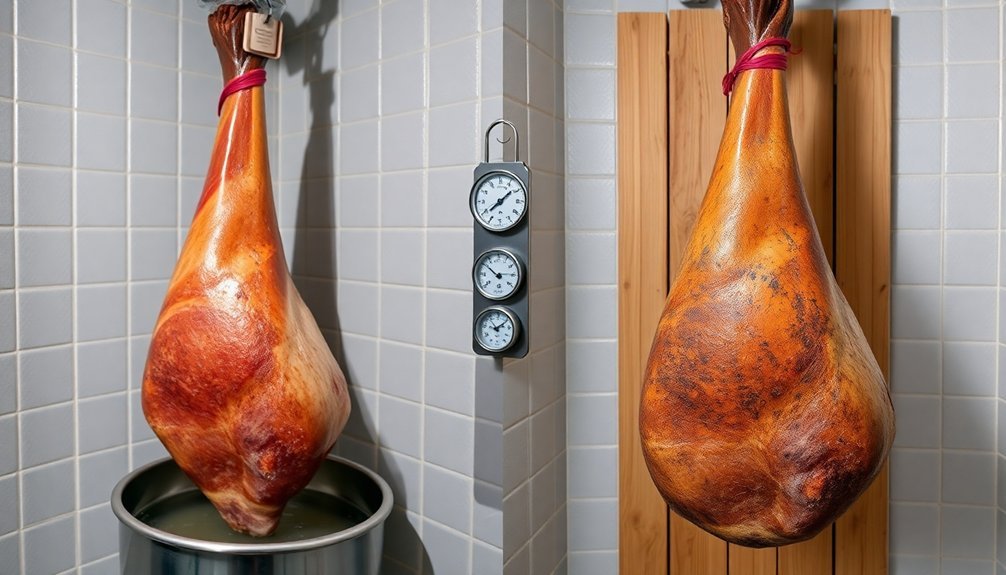
You'll need distinctly different storage conditions for wet-cured versus dry-cured meats, with wet-cured products requiring refrigeration at 34-38°F while dry-cured items can handle room temperatures of 50-60°F.
When managing humidity, both methods demand careful control, with ideal levels around 60-70% to prevent moisture problems and mold growth.
Storage space requirements vary greatly, as wet-cured items must occupy valuable refrigerator space while dry-cured products can be hung in a cool, well-ventilated pantry or cellar.
Temperature Control Requirements
Temperature control plays a pivotal role in determining the success of both wet and dry curing methods.
For wet curing, you'll need to maintain temperatures between 36-40°F (2-5°C), which is similar to your standard refrigerator temperature. If temperatures drop below 36°F, you'll notice the curing process slows down or stops completely.
Don't let temperatures rise above 50°F, as this greatly increases the risk of bacterial growth and spoilage. When using potassium nitrate as a curing agent, aim for temperatures between 46-50°F for best results.
Dry curing requires warmer temperatures, ideally between 50-60°F (10-15°C). This range allows enzymes to effectively break down proteins and fats.
You'll want to maintain consistent temperatures throughout the curing process to guarantee proper moisture loss and prevent spoilage.
When it comes to storage, wet-cured meats must be refrigerated below 40°F in airtight containers to maintain safety and quality.
In contrast, you can store dry-cured meats at room temperature in a cool, dry place with good ventilation.
Both methods require regular monitoring for signs of spoilage and proper protection from contaminants through appropriate packaging.
Humidity Level Management
Along with temperature control, proper humidity management stands as a cornerstone of successful meat curing. In wet curing, you'll maintain precise humidity control through submersion or injection methods, where meat is either placed in brine solutions or directly injected with curing mixtures. This guarantees consistent moisture levels throughout the tissue while preventing bacterial growth.
Dry curing, however, requires a markedly different approach. You'll need to maintain a low-humidity environment, typically using refrigeration at 4-8°C for pork legs. Salt and nitrites play vital roles in reducing moisture and inhibiting bacterial growth under these conditions.
| Aspect | Wet Curing | Dry Curing |
|---|---|---|
| Humidity Level | High, controlled | Low, monitored |
| Method | Submersion/Injection | Salt application |
| Duration | Shorter periods | 10-30 days |
| Risk Factors | Putrefaction if poorly managed | Excessive drying if too dry |
High humidity can greatly impact both methods, potentially causing delayed cure times and promoting bacterial growth. Conversely, while low humidity benefits dry curing, it must be carefully managed to prevent excessive drying that could lead to brittleness in the final product.
Space Needs Comparison
From a spatial perspective, wet and dry curing methods present distinctly different requirements for storage and environmental control.
Dry curing demands more extensive space allocation, as you'll need ample room to lay out meat cuts on racks or hang them with proper air circulation. You'll also require additional space for handling and turning the meat during its extended curing period, which can last weeks or months.
Wet curing, in contrast, offers a more compact solution. You'll only need containers large enough to submerge your meat in the curing liquid, plus storage space for solutions and equipment. While you'll require refrigeration systems to maintain the chilled environment, the overall footprint is typically smaller than dry curing setups.
Environmental control also differs markedly between methods. For dry curing, you must maintain temperatures between 50-60°F with proper ventilation and protection from direct sunlight.
You'll need to monitor conditions consistently to prevent contamination. With wet curing, your primary focus is maintaining a consistently chilled liquid temperature and ensuring uniform cure concentration through occasional stirring.
The sealed nature of wet curing also provides better protection against oxygen exposure and bacterial growth.
Historical Origins and Evolution
Dating back over 40,000 years, meat curing techniques first emerged as essential survival methods, evidenced by ancient cave paintings in Sicily. Early civilizations combined sea salt and plant ash to preserve their meat, while the Sumerians innovated by using sesame oil and salt for both meat and fish preservation by 3000 BC.
The evolution of dry curing can be traced to the third century BC, when Cato documented specific instructions for ham preservation. During medieval times, people relied on a combination of salt, saltpeter, and smoke.
Wet curing developed as an alternative method, offering advantages through brine submersion or injection techniques.
You'll find that both methods underwent significant scientific advancement in the late nineteenth century when researchers discovered the importance of nitrates and nitrites in flavor and color development.
Commercial Vs Traditional Practices

You'll notice stark differences between modern commercial curing operations and traditional heritage techniques, with commercial facilities focusing on high-volume production using advanced climate control systems and standardized protocols.
While traditional methods rely heavily on manual effort and time-honored practices passed down through generations, commercial operations emphasize efficiency through mechanical drying systems and precise environmental controls.
Traditional curing allows for more hands-on customization and attention to individual pieces, whereas commercial methods prioritize consistency across large batches through robust quality control measures and data-driven processes.
Modern Mass Production Methods
Modern mass production methods have revolutionized the curing industry by prioritizing efficiency and environmental sustainability. You'll find that commercial facilities now utilize controlled-environment drying rooms and UV curing systems, which can reduce drying times from hours to seconds while maintaining product quality.
In today's mass production settings, you'll see automated production lines that integrate UV technology seamlessly. These systems don't just speed up the process; they're also more environmentally friendly than traditional methods. You'll notice reduced energy consumption and fewer VOC emissions, helping facilities meet strict environmental regulations.
When you examine quality control in modern facilities, you'll discover standardized protocols ensuring consistency across batches. Advanced climate control systems maintain precise conditions, while robust testing measures track moisture content and other vital parameters.
You'll find that data collection and feedback loops help maintain this consistency.
For scalability, you'll see sophisticated workflow management systems handling large volumes efficiently. These operations require precise control to prevent over-curing or degradation, and they've adapted traditional techniques to work at commercial scales while minimizing waste and maintaining product quality.
Heritage Curing Techniques
While industrial methods prioritize efficiency, traditional heritage curing practices offer a deeper connection to cultural roots and time-tested preservation techniques. Indigenous communities have preserved their heritage through careful curing methods that respect both the food and the environment.
You'll find these techniques deeply woven into cultural traditions, often tied to seasonal changes and spiritual ceremonies.
- Traditional curing emphasizes natural ingredients and minimal equipment, contrasting with modern mass production's reliance on artificial preservatives.
- Indigenous methods like Inuit fish curing and pemmican production have sustained communities through harsh winters for generations.
- Knowledge transfer occurs through hands-on community workshops and oral traditions, rather than standardized manufacturing processes.
- Traditional practices incorporate spiritual and cultural elements, viewing food preservation as more than just a practical necessity.
If you're interested in learning these time-honored techniques, many Indigenous communities offer workshops where you'll learn both the practical skills and cultural significance.
These methods don't just preserve food – they preserve history, ensuring that traditional knowledge continues to benefit future generations. The techniques draw moisture from food naturally while enhancing flavors through time-tested combinations of salt, spices, and smoke.
Quality and Market Value
When it comes to bacon quality and market value, the differences between wet and dry curing methods greatly impact both flavor intensity and consumer preference.
You'll find that dry-cured bacon commands a premium due to its concentrated, robust flavor profile and the extended production time required. This intensive process results in a firmer texture and lower moisture content, which many connoisseurs specifically seek out.
In contrast, you'll notice that wet-cured bacon dominates the commercial market due to its cost-effective production method and consistent results. While it's more succulent and offers a milder, evenly distributed flavor, you'll experience more shrinkage when cooking due to its higher moisture content.
When you're evaluating market value, consider that dry curing requires specific temperature and humidity controls, along with extended curing times, which drive up production costs.
These factors directly influence pricing. While wet curing's shorter production time and efficiency make it more affordable, you'll find that many consumers are willing to pay more for dry-cured bacon's intense flavor profile.
Your choice between the two often depends on whether you prioritize bold, traditional taste or consistent, mild flavoring.
Preservation Mechanisms and Effectiveness
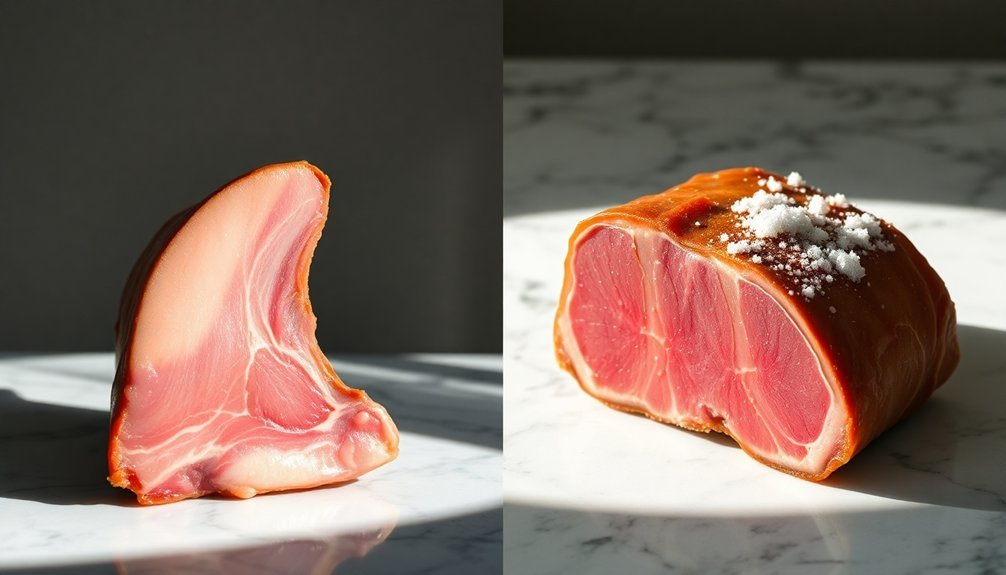
Both wet and dry curing fundamentally protect meat through distinct preservation mechanisms.
In dry curing, salt draws moisture out of the meat through osmosis, creating an inhospitable environment for bacteria. Wet curing, on the other hand, uses a brine solution where osmosis pulls salt and moisture into the meat cells through a semipermeable membrane.
- Dry curing can inhibit bacterial growth by up to 97% using salt and nitrates, making it particularly effective for long-term preservation.
- Wet curing relies on controlled humidity and brine solution to prevent putrefaction while maintaining meat texture.
- Both methods effectively combat Clostridium botulinum through the use of nitrates.
- Sugar in wet curing helps balance flavors while contributing to preservation.
The effectiveness of these methods varies with time and application.
Dry curing requires 15-30 days for pork legs at specific temperatures, while wet curing typically takes several days to a week for standard cuts. For larger pieces like hams, wet curing might extend up to six weeks.
Both methods utilize sodium nitrite and nitrate as curing agents, though dry curing often employs these for longer preservation periods.
Product Types and Uses
A diverse range of products benefits from either wet or dry curing methods, each suited to specific preservation needs.
When you're working with wet curing, you'll find specialized materials like synthetic-fiber plastic-backed blankets and wood-pulp fiber fabrics that guarantee even water distribution across concrete surfaces. These products are particularly effective when you need continuous moisture retention for at least seven days.
For membrane curing, you'll encounter two main product varieties: clear and white pigmented compounds. These form protective barriers on the concrete surface, making them ideal when you can't maintain constant moisture levels.
While wet curing materials like burlap, paper, and plastic sheeting require more hands-on management, they're vital for projects where maximum strength development is essential. You'll need to keep these materials consistently saturated to prevent surface damage from alternating wet and dry cycles.
When choosing between flooding methods and membrane compounds, consider your project's specific requirements and available resources, as wet curing methods typically demand more labor and higher costs but often deliver superior results in important applications.
Frequently Asked Questions
Can I Switch Between Wet and Dry Curing Methods Mid-Process?
You shouldn't switch between wet and dry curing methods mid-process. It'll disrupt flavor development, compromise preservation, and create inconsistent results. Stick with one method from start to finish for the best outcome.
What Safety Precautions Should I Take When Curing Meat at Home?
You'll need to sanitize all equipment, maintain temperatures between 35-40°F, use food-grade containers, prevent cross-contamination, and follow exact cure measurements. Always keep raw meat separate from cooked products during storage.
How Do Different Meat Cuts Respond to Wet Versus Dry Curing?
You'll find thick cuts like prosciutto work best with dry curing for intense flavor, while smaller cuts like bacon respond better to wet curing, staying juicier and absorbing flavors more evenly.
Does Altitude Affect the Success of Wet or Dry Curing?
Yes, altitude affects both methods. You'll find dry curing needs extra monitoring due to faster evaporation at high altitudes, while wet curing's more stable but still requires adjustments in brine concentration and timing.
Can I Reuse Brine Solution or Dry Cure Mixture Multiple Times?
You can reuse dry cure mixture a few times by mixing in fresh ingredients, but brine solution should only be reused once or twice after reboiling. Always monitor for changes in effectiveness and safety.
In Summary
You've now seen the key differences between wet and dry curing methods. Both techniques offer unique advantages, so your choice should depend on your specific needs. Whether you're looking for intense flavors through dry curing or seeking the convenience of wet curing, you'll find each method has its place. Remember to take into account factors like time, storage, and intended use when deciding which approach works best for your project.
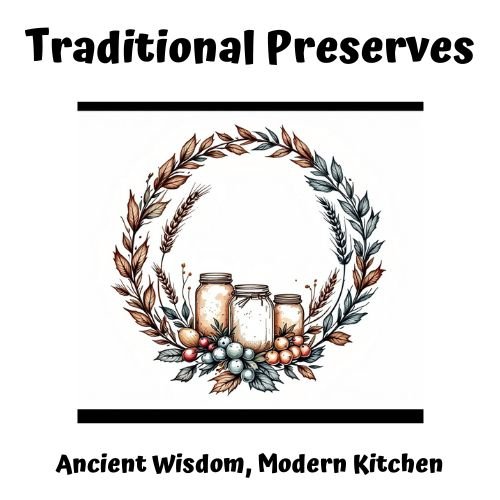

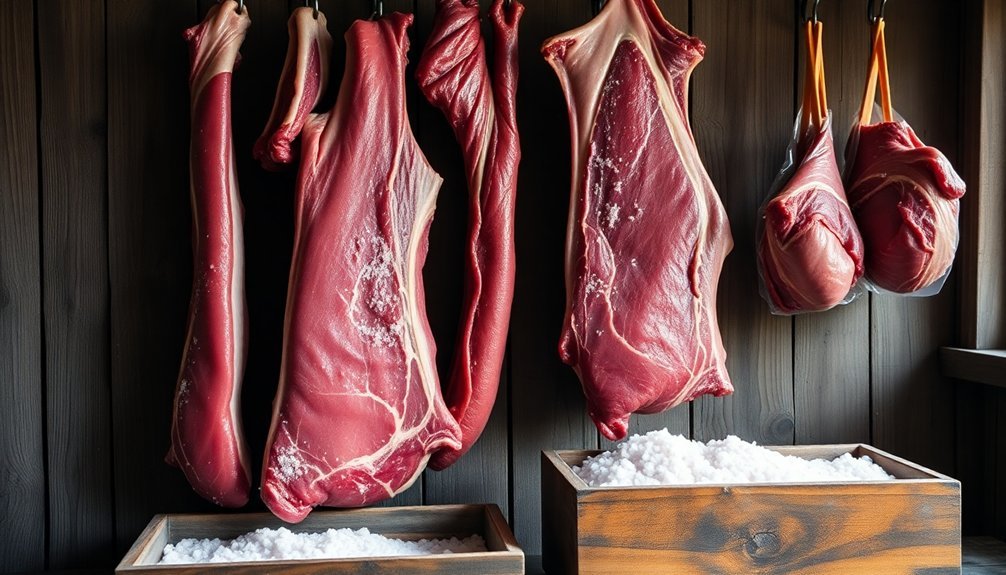

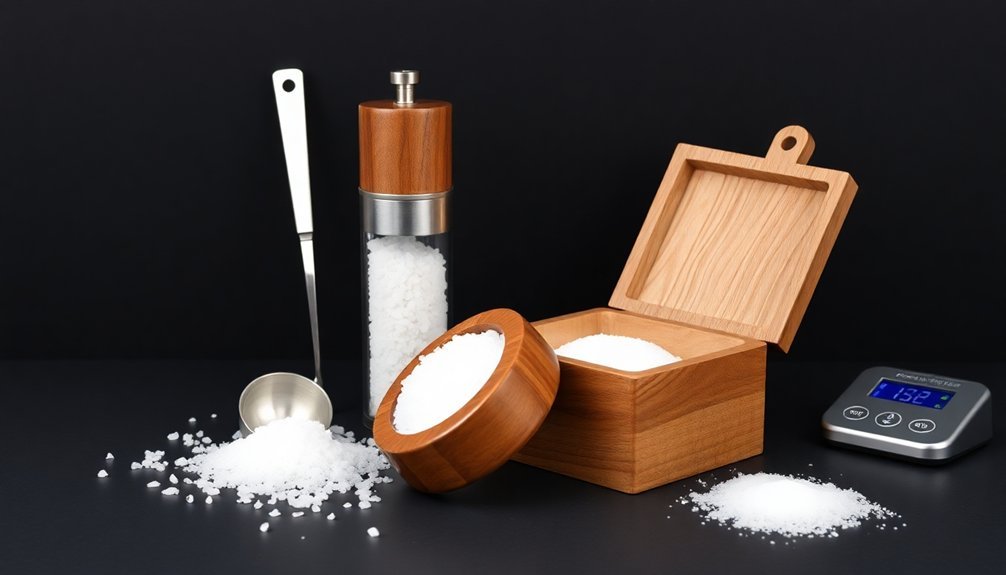
Leave a Reply